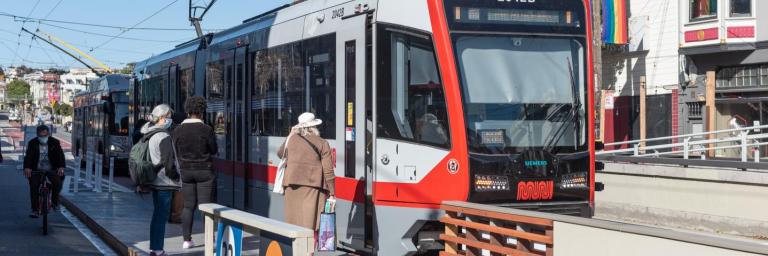So that Muni Metro is the best option for people taking crosstown trips, SFMTA staff are working to identify ways to reduce Muni Metro travel times, increase frequency, improve reliability and reduce (or even eliminate!) delays caused by subway congestion for customers. It is well-documented that the J Church service in the subway has contributed to the congestion plaguing service reliability for decades.
The quality of Muni Metro service before the COVID-19 pandemic was unacceptable. Muni Metro was regularly plagued with frustrating delays caused by congestion in the subway. The Market Street subway trains were arriving more quickly than they were leaving, leading to trains queuing, or becoming “stuck” in the tunnel traffic.
On average 30% of trains during each day’s morning peak were stuck in congestion trying to get to Embarcadero. At that time, we were running 43 trains per hour in the Muni Metro subway. That queuing is representative of a lot of congestion!
Surface-only J Church Pilot Project
Along with all other Muni Metro lines, the J Church service was temporarily suspended at the beginning of the COVID-19 pandemic in April 2020. To reduce congestion in the subway, a pilot project limiting the number of trains operating in the tunnel was launched as Muni Metro rail service was restored. To do this, we determined that the J Church would be run as a surface-only route to alleviate subway congestion.
The J Church was selected because its surface-level route constraints limit the line to one-car trains, which reduces the total number of people the Muni Metro subway can serve when the J Church is operating there. In addition, traveling a shorter surface route saves travel time for the J Church, allowing for increased frequency and capacity.
Creating a surface-only route for the train also required a new transfer at Market and Church Street to the Church Street Station for those J Church riders whose trips continue in the Muni Metro subway. To assist Muni customers transferring between the J Church and Market Street transportation we implemented temporary transfer improvements on Church Street from 15th Street to Duboce Avenue.
Once the subway re-opened in May 2021, we began evaluating the design and operation of the pilot project. We conducted a public survey about the accessibility changes in summer 2021, in addition to reaching out to merchants in the project area. We also analyzed travel time data and other performance metrics.
Outcomes
From a subway reliability perspective, when the number of lines serving the subway was reduced in 2021, Muni Metro had the fastest, most reliable subway service the city has ever seen. This massive improvement is mostly due to a reduction in subway congestion. In 2021, when we only ran 25 trains per hour, less than 3% of trains in the morning peak period had to wait in the tunnel before arriving at Embarcadero. The number of hours Muni Metro trains spend stopped in the tunnel (either not at a station, or for too long at a station) dropped 75% between 2019 and 2021. Initial findings also showed a 15% improvement in reliability on the J Church.
This change also maximized subway capacity by only running lines that can operate two-car trains. In addition, the shortened, surface-only J Church route allowed for more frequent and reliable service. And, while J Church customers traveling further than Market and Church were required to transfer at the Church Station, 73% of trips transferring at Church Station in July 2021 had wait times of six minutes or less.
The pilot project limiting the number of trains operating in the tunnel succeeded in reducing subway congestion delays. The removal of the J Church out of the subway also contributed to other noteworthy improvements to Muni Metro service systemwide, including significantly reduced wait times and a significant decline in trip variability. This translated into faster, more reliable rail service in the core of our network.
Next steps
The goal now is to maintain those 2021 improvements to delay and reliability while carefully increasing the number of trains in the subway. As people return to Muni, we will need to increase train service, but subway delay and congestion are already creeping back up. As ridership increases, we are monitoring and regularly reporting on subway health by tracking the number of trains in the subway, the headways (the duration of the time between trains moving in the same direction) ridership and crowding. We have created dashboards that are helping show Muni Metro health so that we can track service quality and report its status to the SFMTA Board.
As limiting trains in the subway reduces the number of people the subway can serve, we also are looking at ways to maximize capacity by running two- or three-car trains and improving reliability for the entire Muni Metro system. We aim to use shuttle trains to supplement service and increase frequency in the subway, and to close gaps on the surface and address other service reliability issues. Another consideration being studied is a surface-only J Church route that would turn onto Market Street to continue to the Embarcadero on the surface.
